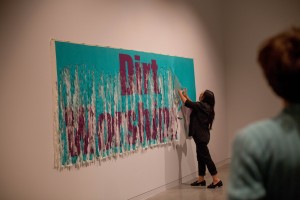On January 23rd I attended the theatre performance, “Jack Charles vs. The Crown.” This production is part of the PuSH festival in Vancouver. This festival was introduced as a festival to bring in performing art productions from around the world to Vancouver. Jack Charles vs. The Crown has been performed around the world and has received positive reviews everywhere it goes. Jack Charles wrote his piece with the help of John Romeril. The inspiration to make his story a theatre production came from the positive response he received from his documentary, Bastardy, which was released in 2008.
Jocelyn Macdougall, from the PuSH international performing arts festival, gave the opening remarks to the production “Jack Charles vs. The Crown”. She spoke about the festival it self and then she recognized the land we were on. This acknowledgement of the land was both thorough and heartfelt. She talked about all the territories that the theatre was located upon and went on to describe the meaning of unceeded and stated, “this is land that was not freely given.”
The space itself was set up much like that of a living room on the far right, with a band on the far left side of the stage. In the back center of the stage there was a pottery wheel. This wheel was used at many different times throughout the production. The set made you feel as though he was simply telling you a story and you were in his living room with him, or beside him as he worked in his pottery shop rather than being in a theatre. This lighthearted atmosphere helped people feel at ease as he told his life story and the hurt and pain within it. It reminded me of sitting with my grandmother as we had tea and she talked about when my dad was a little boy. Listening to her stories has been a big part of my life and hearing Jack’s stories reminded me of sitting in my grandmother’s living room and listening to whatever she wanted to share with me.
As the lights dimmed the band members came to the stage and started playing a slow, melancholy piece. Jack came out to the stage and sat behind the pottery wheel. He proceeded to work with the clay on the wheel and mold it into a beautiful piece of art. While he was working on his pottery there was a clip rolling behind him from his documentary, Bastardy. The clip was of him taking drugs. It was a very powerful clip that caused many in the audience to divert their eyes, cringe and squirm in their seats. I initially looked away as many around me did. Then I realized the courage he had to share this part of his life, this reality that I couldn’t personally relate to, but wanted to try and understand. So I watched as he put a needle in his arm and talked about the way the drugs don’t’ effect him as much anymore. He had used them for so long that people around him couldn’t tell if he was high or not.
Throughout the production Jack tells stories in chronological order of his life. Within each part of his life he has faced racism, oppression, and pain. When he was in boarding school he had a few pictures to share. One of these pictures was in the winter where he had a chunk of snow on his head. This snow was a metaphor for the world he had inhabited. His world was filled with white all around him, and there was him, the only dark skinned student. During his time at the boarding school he was also asked to sing a song. This song was about how the white man had helped the Aboriginal peoples on the land, and without the white man they wouldn’t be successful. At the time he didn’t realize what the song was about and why he was asked to sing it. He was simply proud of himself for being asked to sing a song. The school had taken advantage of the colour of his skin and asked him to perform a song that was demeaning and hurtful towards his people.
Watching the production you can already tell that the pottery wheel is an important aspect of Jack Charles’ life. He repeatedly returns to the pottery wheel throughout the piece and seems to be very comfortable talking about hard issues when he is behind the wheel. He speaks of pottery as his way of finding freedom. Pottery was his release. He expressed his feeling when working with pottery as a way of setting him free, making him feel like a child playing in the mud. His life was determined by the crown, it was shaped and molded by the crown and all he was, was a number to them. His prison number was how he was seen. His past followed him wherever he went and was described by him as something that shadowed and stalked him. When he was molding the clay he had control of his life. He could mold it in anyway he wants. He created 3 different pottery pieces throughout the show and added them to a shelf behind him. They were all different shapes and sizes and each one unique and beautiful.


